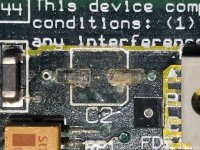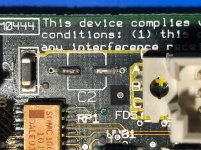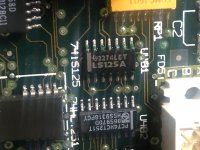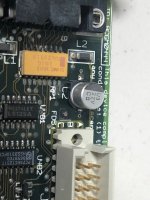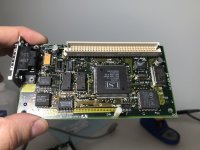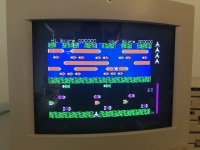Hey there! Please bear with me on this long topic. I acquired a 575 recently (a long sought-after machine for me), with a IIe card (my first real foray into Apple II), and it's becoming my big "learn to recap" impetus. So I am simultaneously assessing the board and thinking about how best to properly restore it and keep it happy for years to come.
Though I haven't tested everything, the machine boots up fine, sound works, everything seems fine from the "boot it up and play a game" test. The display does have a relatively slight but noticeable pinkish tint which seems to either subdue over time or my eyes just adjust to.
After heating up the rear panel cover tabs gently with a heat gun to prevent snapping, I removed the logic board. (I snapped my childhood 550's tabs clear off years ago, so I was hyper-aware of the danger here...)
Looks pretty good at first glance. No obviously leaking capacitors or corrosion; the square battery was intact before I removed it.
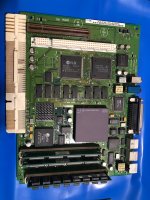
A bit of probably-harmless-seeming white gunk near the CPU and ROM slots:
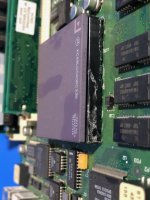
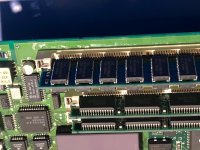
Flipped the board and - uh oh! What's all this?
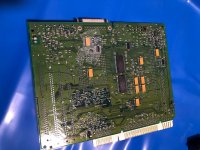
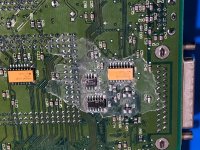
Hmm. No nearby components look fried, and it doesn't seem corrosive -- what is this, a big spooge of flux leftover from mfg? Any ideas? I started cleaning it up with 99% iso; it's a bit stubborn in that it thinned out and spread around a bunch.
As for the IIe card's two caps -
This one seems ok:
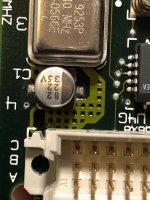
But this one looks pretty bad, right? Corroded contacts, especially the negative terminal area.
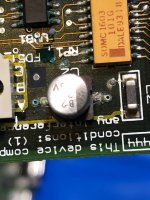
Probably not safe to use until replacing?
(A bummer, since I have only the tiniest bit of Apple II experience and was looking forward to diving in. It will probably take me a month or two before I feel comfortable recapping a valuable thing - not to mention sourcing tools and caps.)
------------------------------------------------------------------------------------
OK! Now for the recap strategy.
I've been soldering cable repairs and through holes since I was a kid, but I'm not expertly skilled and have never touched SMDs.
My basic learning plan is:
- Play with surface mount soldering/desoldering on some junk boards. I've been collecting a few random boards with SMDs (e.g. from a cable modem, HDD controller) for this. Nothing yet with caps that look just like the Mac ones.
- Attempt a full recap on a less-important-to-me Mac board, or two. I have a couple of LC III boards, and would probably start with one of those.
- Apple IIe card recap
- Recap 575 and other valuable boards
Equipment:
I don't mind investing a bit of cash in tools to make the job easier and the results nicer. I have a bunch of Mac boards that need recapping at this point. If I get the hang of this, I will probably want to do it a lot. Thousands of $$ for single tools is out of the question for me but I'm happy to spend some $500 or $600 (and maybe more down the road) if it brings real benefit.
- I bought a small bent tip for my ol' reliable Hakko FX-888. But maybe I should upgrade to an FX-951? Anyone use a 951 for Mac work? Any recommended tips?
- Hot air rework. Is it really the best? Last I did a deep dive search on this, I came to the conclusion that "press down and slowly twist" was a better cap-removal method on these boards than hot air or dual irons, with the latter two being more tricky and error-prone (melting things). That said, this one I've seen recommended and is supposed to be nice for the price.
- Microscope. I should probably wait on this one - my close-up vision is pretty OK, and this would probably blow out my budget. Maybe an acquisition down the road or if I sell some stuff to offset. Either way, any recs for a price/performance microscope for this type of work?
- Caps. Electrolytic vs tantalum seems to be a great debate? My instinct is to go electrolytic, as high-quality (and preferably over-rated for volts) as I can. The circuit is designed for these caps, no? I kind of want to 'wait and see' what happens in the long run with tantalum-recapped boards before going the same route, as the rumors of failing closed/shorted (or with an explosion) give me pause. But maybe I'm just being paranoid. Can anyone recommend some high-quality electrolytics and the best place to buy?
Thanks for reading my long and winding thread. I'm looking forward to any thoughts and advice you all might have!
Though I haven't tested everything, the machine boots up fine, sound works, everything seems fine from the "boot it up and play a game" test. The display does have a relatively slight but noticeable pinkish tint which seems to either subdue over time or my eyes just adjust to.
After heating up the rear panel cover tabs gently with a heat gun to prevent snapping, I removed the logic board. (I snapped my childhood 550's tabs clear off years ago, so I was hyper-aware of the danger here...)
Looks pretty good at first glance. No obviously leaking capacitors or corrosion; the square battery was intact before I removed it.

A bit of probably-harmless-seeming white gunk near the CPU and ROM slots:


Flipped the board and - uh oh! What's all this?


Hmm. No nearby components look fried, and it doesn't seem corrosive -- what is this, a big spooge of flux leftover from mfg? Any ideas? I started cleaning it up with 99% iso; it's a bit stubborn in that it thinned out and spread around a bunch.
As for the IIe card's two caps -
This one seems ok:

But this one looks pretty bad, right? Corroded contacts, especially the negative terminal area.

Probably not safe to use until replacing?
(A bummer, since I have only the tiniest bit of Apple II experience and was looking forward to diving in. It will probably take me a month or two before I feel comfortable recapping a valuable thing - not to mention sourcing tools and caps.)
------------------------------------------------------------------------------------
OK! Now for the recap strategy.
I've been soldering cable repairs and through holes since I was a kid, but I'm not expertly skilled and have never touched SMDs.
My basic learning plan is:
- Play with surface mount soldering/desoldering on some junk boards. I've been collecting a few random boards with SMDs (e.g. from a cable modem, HDD controller) for this. Nothing yet with caps that look just like the Mac ones.
- Attempt a full recap on a less-important-to-me Mac board, or two. I have a couple of LC III boards, and would probably start with one of those.
- Apple IIe card recap
- Recap 575 and other valuable boards
Equipment:
I don't mind investing a bit of cash in tools to make the job easier and the results nicer. I have a bunch of Mac boards that need recapping at this point. If I get the hang of this, I will probably want to do it a lot. Thousands of $$ for single tools is out of the question for me but I'm happy to spend some $500 or $600 (and maybe more down the road) if it brings real benefit.
- I bought a small bent tip for my ol' reliable Hakko FX-888. But maybe I should upgrade to an FX-951? Anyone use a 951 for Mac work? Any recommended tips?
- Hot air rework. Is it really the best? Last I did a deep dive search on this, I came to the conclusion that "press down and slowly twist" was a better cap-removal method on these boards than hot air or dual irons, with the latter two being more tricky and error-prone (melting things). That said, this one I've seen recommended and is supposed to be nice for the price.
- Microscope. I should probably wait on this one - my close-up vision is pretty OK, and this would probably blow out my budget. Maybe an acquisition down the road or if I sell some stuff to offset. Either way, any recs for a price/performance microscope for this type of work?
- Caps. Electrolytic vs tantalum seems to be a great debate? My instinct is to go electrolytic, as high-quality (and preferably over-rated for volts) as I can. The circuit is designed for these caps, no? I kind of want to 'wait and see' what happens in the long run with tantalum-recapped boards before going the same route, as the rumors of failing closed/shorted (or with an explosion) give me pause. But maybe I'm just being paranoid. Can anyone recommend some high-quality electrolytics and the best place to buy?
Thanks for reading my long and winding thread. I'm looking forward to any thoughts and advice you all might have!
Last edited by a moderator:

